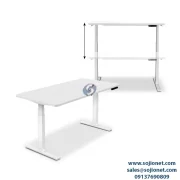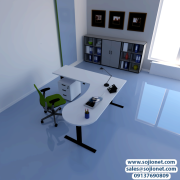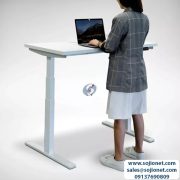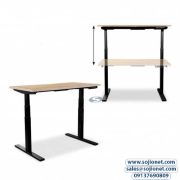Adjustable Office Table
Adjustable Office Table
Adjustable Office Table
Adjustable Office Table
Adjustable Office Table
Adjustable Office Table
Adjustable Office Table
Adjustable Office Table
Adjustable Office Table
Are you tired of feeling sluggish and unproductive at work? Do you suffer from back or neck pain as a result of your sedentary lifestyle? If so, it’s time to try the Modern Quality Standing Table.
Standing desks have become increasingly popular in recent years, and for good reason. Research has shown that sitting for long periods of time can have a negative impact on our health, leading to a host of problems including obesity, heart disease, and even cancer. By standing while you work, you can improve your posture, boost your energy levels, and reduce your risk of these and other health issues.
But not all standing desks are created equal. The Modern Quality Standing Table is the ultimate solution for those who want the best of both worlds: the convenience and productivity of a traditional desk, combined with the health benefits of a standing desk.
Here are just a few of the many benefits you can expect when you switch to a Modern Quality Standing Table:
- Improved Posture: By standing while you work, you naturally improve your posture, which can help alleviate back and neck pain and reduce the risk of future injuries.
- Increased Energy Levels: Sitting for long periods of time can make you feel sluggish and tired. Standing, on the other hand, can help increase blood flow and oxygen to your brain, boosting your energy levels and keeping you alert and focused.
- Burn More Calories: Standing burns more calories than sitting, helping you maintain a healthy weight and reduce your risk of obesity and related health issues.
- Reduced Risk of Heart Disease: Research has shown that sitting for long periods of time can increase your risk of heart disease. By standing more, you can reduce your risk and improve your heart health.
- Lower Risk of Type 2 Diabetes: Standing can help regulate blood sugar levels, reducing the risk of type 2 diabetes.
- Improved Mood: Standing can help reduce stress and improve your mood, leading to a more positive and productive work environment.
- Increased Productivity: Studies have shown that standing can help increase productivity, leading to better work performance and results.
- Greater Comfort: The Modern Quality Standing Table is designed with ergonomics in mind, ensuring that you stay comfortable and supported throughout the day.
- Customizable Height: The table can be easily adjusted to your preferred height, ensuring that you are comfortable and working at the optimal level.
- More Versatile Workspace: The Modern Quality Standing Table provides a more versatile workspace, allowing you to switch between sitting and standing as needed throughout the day.
- Improved Circulation: Standing can help improve circulation, reducing the risk of blood clots and related health issues.
- Better Breathing: Standing can help improve lung function and breathing, reducing the risk of respiratory issues.
- Improved Digestion: Standing can help improve digestion and reduce the risk of digestive issues.
- Better Sleep: Standing can help improve sleep quality, leading to better overall health and wellness.
- Reduced Risk of Cancer: Research has shown that sitting for long periods of time can increase the risk of certain types of cancer. By standing more, you can reduce your risk and improve your overall health.
If you suffer from back or neck pain as a result of your sedentary lifestyle, we recommend pairing your Modern Quality Standing Table with an ergonomic chair. Together, these products can help alleviate your pain and provide a more comfortable and healthy work environment.
Don’t wait any longer to start improving your health and productivity. Place your order today for the Modern Quality Standing Table from Sojionet Furniture. We offer door-to-door delivery and installation in Lekki Lagos State and every city in Nigeria, making it easy and convenient for you to place order. Just contact us for the best adjustable table in Lagos Nigeria.
The Height of Office Table
The height of an office table is a critical factor that can significantly impact comfort, productivity, and overall well-being in the workplace. Office tables come in various heights to accommodate different tasks, user preferences, and ergonomic requirements. Understanding the importance of table height and how to choose the right height for your needs is essential for creating a comfortable and ergonomic workspace.
- Importance of Office Table Height:
- Ergonomics: The height of an office table plays a crucial role in maintaining proper ergonomic posture while working. A table that is too high or too low can lead to discomfort, fatigue, and musculoskeletal issues such as neck strain, back pain, and wrist discomfort.
- Comfort: An appropriately sized table height promotes comfort and allows users to work efficiently for extended periods without experiencing discomfort or fatigue.
- Accessibility: The height of the table should be suitable for the user’s height and reach, ensuring that essential items and tools are easily accessible without stretching or straining.
- Functionality: The height of the table should accommodate the tasks performed at the workstation, whether it involves typing on a keyboard, writing on paper, or using other office equipment and tools.
- Factors to Consider When Determining Office Table Height:
- User Height: The height of the office table should be appropriate for the user’s height to ensure ergonomic comfort. Taller individuals may require taller tables to prevent stooping or bending, while shorter individuals may prefer lower tables to maintain proper posture.
- Chair Height: The height of the office chair and the user’s seated posture should complement the table height. The user’s feet should rest flat on the floor or on a footrest, with thighs parallel to the ground and arms comfortably positioned on the table surface.
- Task Requirements: Consider the tasks performed at the workstation and the equipment used. For example, a table used primarily for computer work should be at a height that allows for comfortable typing and viewing of the monitor. Adjustable-height tables are ideal for accommodating different tasks and preferences.
- Clearance Space: Ensure that there is adequate clearance space between the user’s knees and the underside of the table to prevent discomfort and promote freedom of movement.
- Table Accessories: Consider the use of table accessories such as keyboard trays, monitor risers, and adjustable monitor arms to customize the height and improve ergonomics.
- Standard Office Table Heights:
- Standard office table heights typically range from 28 to 30 inches (71 to 76 centimeters) for desks used in seated workstations. This height is suitable for most adults and accommodates standard office chairs with seat heights ranging from 16 to 20 inches (41 to 51 centimeters).
- Standing desks, which allow users to work while standing, typically have adjustable heights ranging from 36 to 48 inches (91 to 122 centimeters) to accommodate different user preferences and heights.
- Adjustable-height tables provide flexibility and versatility by allowing users to customize the height according to their preferences and tasks. These tables often feature a height adjustment mechanism that allows for seamless transition between sitting and standing positions.
- Tips for Choosing the Right Office Table Height:
- Measure the user’s seated and standing height to determine the appropriate table height range.
- Consider adjustable-height tables for flexibility and adaptability to different tasks and user preferences.
- Ensure adequate clearance space and ergonomic alignment between the user, chair, and table surface.
- Test different table heights and configurations to find the most comfortable and ergonomic option for the user’s needs.
- Consult ergonomic guidelines and resources to ensure proper posture and ergonomics in the workplace.
In conclusion, the height of an office table is a crucial ergonomic factor that can significantly impact comfort, productivity, and overall well-being in the workplace. By considering user height, task requirements, and ergonomic principles, individuals and businesses can choose office tables that promote comfort, functionality, and optimal performance in the office environment.
The Height of Office Table
The height of an office table is a critical factor that can significantly impact comfort, productivity, and overall well-being in the workplace. Office tables come in various heights to accommodate different tasks, user preferences, and ergonomic requirements. Understanding the importance of table height and how to choose the right height for your needs is essential for creating a comfortable and ergonomic workspace.
- Importance of Office Table Height:
- Ergonomics: The height of an office table plays a crucial role in maintaining proper ergonomic posture while working. A table that is too high or too low can lead to discomfort, fatigue, and musculoskeletal issues such as neck strain, back pain, and wrist discomfort.
- Comfort: An appropriately sized table height promotes comfort and allows users to work efficiently for extended periods without experiencing discomfort or fatigue.
- Accessibility: The height of the table should be suitable for the user’s height and reach, ensuring that essential items and tools are easily accessible without stretching or straining.
- Functionality: The height of the table should accommodate the tasks performed at the workstation, whether it involves typing on a keyboard, writing on paper, or using other office equipment and tools.
- Factors to Consider When Determining Office Table Height:
- User Height: The height of the office table should be appropriate for the user’s height to ensure ergonomic comfort. Taller individuals may require taller tables to prevent stooping or bending, while shorter individuals may prefer lower tables to maintain proper posture.
- Chair Height: The height of the office chair and the user’s seated posture should complement the table height. The user’s feet should rest flat on the floor or on a footrest, with thighs parallel to the ground and arms comfortably positioned on the table surface.
- Task Requirements: Consider the tasks performed at the workstation and the equipment used. For example, a table used primarily for computer work should be at a height that allows for comfortable typing and viewing of the monitor. Adjustable-height tables are ideal for accommodating different tasks and preferences.
- Clearance Space: Ensure that there is adequate clearance space between the user’s knees and the underside of the table to prevent discomfort and promote freedom of movement.
- Table Accessories: Consider the use of table accessories such as keyboard trays, monitor risers, and adjustable monitor arms to customize the height and improve ergonomics.
- Standard Office Table Heights:
- Standard office table heights typically range from 28 to 30 inches (71 to 76 centimeters) for desks used in seated workstations. This height is suitable for most adults and accommodates standard office chairs with seat heights ranging from 16 to 20 inches (41 to 51 centimeters).
- Standing desks, which allow users to work while standing, typically have adjustable heights ranging from 36 to 48 inches (91 to 122 centimeters) to accommodate different user preferences and heights.
- Adjustable-height tables provide flexibility and versatility by allowing users to customize the height according to their preferences and tasks. These tables often feature a height adjustment mechanism that allows for seamless transition between sitting and standing positions. Check out our height adjustable table in Lagos Nigeria.
- Tips for Choosing the Right Office Table Height:
- Measure the user’s seated and standing height to determine the appropriate table height range.
- Consider adjustable-height tables for flexibility and adaptability to different tasks and user preferences.
- Ensure adequate clearance space and ergonomic alignment between the user, chair, and table surface.
- Test different table heights and configurations to find the most comfortable and ergonomic option for the user’s needs.
- Consult ergonomic guidelines and resources to ensure proper posture and ergonomics in the workplace.
In conclusion, the height of an office table is a crucial ergonomic factor that can significantly impact comfort, productivity, and overall well-being in the workplace. By considering user height, task requirements, and ergonomic principles, individuals and businesses can choose office tables that promote comfort, functionality, and optimal performance in the office environment.
Make your office a hub of productivity and health with a next-level electric standing table. Designed to move as you do, this table supports smooth transitions and encourages a more active daily routine. Standing periodically reduces the risk of stiffness and promotes better circulation, keeping you sharp and motivated. The modern aesthetic fits beautifully in any workspace, offering a subtle yet powerful upgrade to your professional image. Show your dedication to a better way of working and inspire those around you by choosing an electric standing table that keeps pace with your goals.











